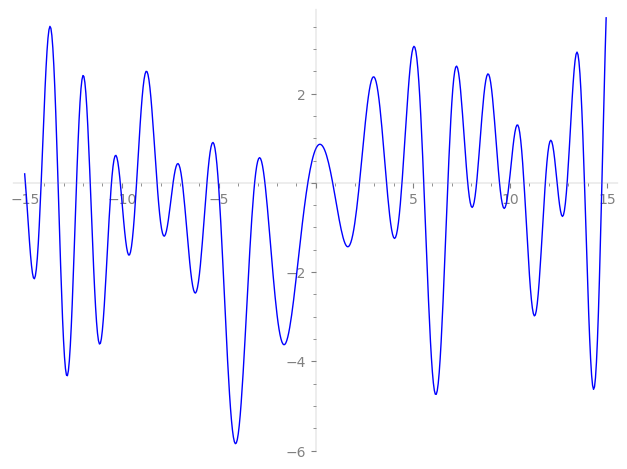| L(s) = 1 | + (−1 + i)2-s − 2i·4-s + (−1.76 + 4.67i)5-s + (−4.32 + 4.32i)7-s + (2 + 2i)8-s + (−2.90 − 6.44i)10-s − 9.81·11-s + (−13.2 − 13.2i)13-s − 8.65i·14-s − 4·16-s + (18.6 − 18.6i)17-s − 16.6i·19-s + (9.35 + 3.53i)20-s + (9.81 − 9.81i)22-s + (11.3 + 11.3i)23-s + ⋯ |
| L(s) = 1 | + (−0.5 + 0.5i)2-s − 0.5i·4-s + (−0.353 + 0.935i)5-s + (−0.618 + 0.618i)7-s + (0.250 + 0.250i)8-s + (−0.290 − 0.644i)10-s − 0.892·11-s + (−1.02 − 1.02i)13-s − 0.618i·14-s − 0.250·16-s + (1.09 − 1.09i)17-s − 0.874i·19-s + (0.467 + 0.176i)20-s + (0.446 − 0.446i)22-s + (0.494 + 0.494i)23-s + ⋯ |
\[\begin{aligned}\Lambda(s)=\mathstrut & 810 ^{s/2} \, \Gamma_{\C}(s) \, L(s)\cr =\mathstrut & (0.991 + 0.129i)\, \overline{\Lambda}(3-s) \end{aligned}\]
\[\begin{aligned}\Lambda(s)=\mathstrut & 810 ^{s/2} \, \Gamma_{\C}(s+1) \, L(s)\cr =\mathstrut & (0.991 + 0.129i)\, \overline{\Lambda}(1-s) \end{aligned}\]
Particular Values
| \(L(\frac{3}{2})\) |
\(\approx\) |
\(0.7685298324\) |
| \(L(\frac12)\) |
\(\approx\) |
\(0.7685298324\) |
| \(L(2)\) |
|
not available |
| \(L(1)\) |
|
not available |
\(L(s) = \displaystyle \prod_{p} F_p(p^{-s})^{-1} \)
| $p$ | $F_p(T)$ |
|---|
| bad | 2 | \( 1 + (1 - i)T \) |
| 3 | \( 1 \) |
| 5 | \( 1 + (1.76 - 4.67i)T \) |
| good | 7 | \( 1 + (4.32 - 4.32i)T - 49iT^{2} \) |
| 11 | \( 1 + 9.81T + 121T^{2} \) |
| 13 | \( 1 + (13.2 + 13.2i)T + 169iT^{2} \) |
| 17 | \( 1 + (-18.6 + 18.6i)T - 289iT^{2} \) |
| 19 | \( 1 + 16.6iT - 361T^{2} \) |
| 23 | \( 1 + (-11.3 - 11.3i)T + 529iT^{2} \) |
| 29 | \( 1 - 34.0iT - 841T^{2} \) |
| 31 | \( 1 - 29.4T + 961T^{2} \) |
| 37 | \( 1 + (27.3 - 27.3i)T - 1.36e3iT^{2} \) |
| 41 | \( 1 - 22.4T + 1.68e3T^{2} \) |
| 43 | \( 1 + (25.2 + 25.2i)T + 1.84e3iT^{2} \) |
| 47 | \( 1 + (-44.0 + 44.0i)T - 2.20e3iT^{2} \) |
| 53 | \( 1 + (-14.0 - 14.0i)T + 2.80e3iT^{2} \) |
| 59 | \( 1 - 21.0iT - 3.48e3T^{2} \) |
| 61 | \( 1 - 69.8T + 3.72e3T^{2} \) |
| 67 | \( 1 + (-1.75 + 1.75i)T - 4.48e3iT^{2} \) |
| 71 | \( 1 - 99.0T + 5.04e3T^{2} \) |
| 73 | \( 1 + (0.175 + 0.175i)T + 5.32e3iT^{2} \) |
| 79 | \( 1 + 64.2iT - 6.24e3T^{2} \) |
| 83 | \( 1 + (45.7 + 45.7i)T + 6.88e3iT^{2} \) |
| 89 | \( 1 + 43.0iT - 7.92e3T^{2} \) |
| 97 | \( 1 + (-117. + 117. i)T - 9.40e3iT^{2} \) |
| show more | |
| show less | |
\(L(s) = \displaystyle\prod_p \ \prod_{j=1}^{2} (1 - \alpha_{j,p}\, p^{-s})^{-1}\)
Imaginary part of the first few zeros on the critical line
−10.07538721984879234237724226529, −9.237220231176079331514942544852, −8.183369883758705154642887043314, −7.35607637837677376410449896158, −6.87851229036842238805571665308, −5.61312198847010356429378123527, −5.02288178664632673123558562749, −3.15697466020889892965899573146, −2.62685035408142810709212772317, −0.41627122456113954109156585690,
0.863795178830038281532904534143, 2.24473330295662084675582310270, 3.63899326531738397845610320953, 4.43406641333529866884235715751, 5.55602989055543432050713996374, 6.79752357340547103057804922933, 7.82044225624131951324391791289, 8.277875689460521146646261410806, 9.457771244053225121218849988032, 9.956357314438036598634961914365

